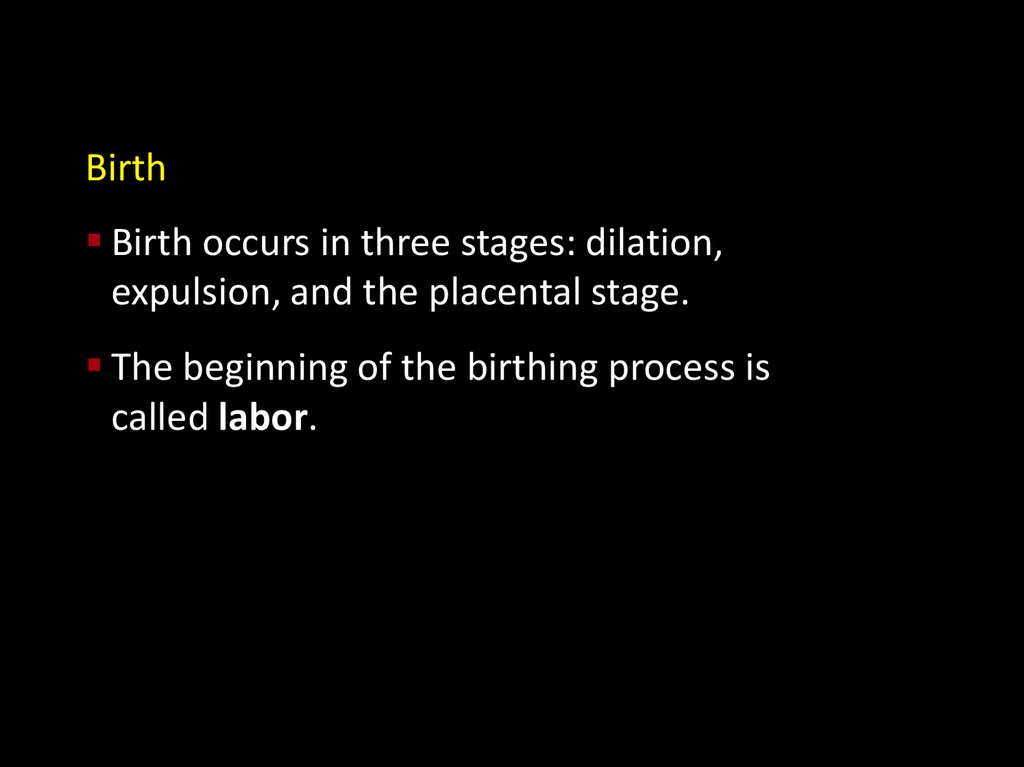Similar presentations:
7-week-old human embryo
1. 7-week-old human embryo
2. Human Development
3.
It is difficult to imagine that each of us began life asa single cell about the size of the dot at the end of
this sentence.
4.
5.
FertilizationProcess of a sperm
cell joining with an
egg cell – zygote.
Each normally
has 23
chromosomes.
Fertilization restores 46 chromosomes.
6. Cleavage
• A succession of rapid cell divisions thatfollow fertilization.
• The embryo does not enlarge during this
period of development.
• Cleavage simply partitions the cytoplasm
of one large cell (the zygote) into many
small cells called blastomeres.
7.
8. Cleavage (divide via mitosis) forms the 2 cell stage
9. They split again to form the 4 cell stage
10. And again to form the 8 cell stage…
11. And eventually form a Morula
12. Morula
• Continuedcleavage produces
a solid ball of cells
known as morula.
• 16-64 cells.
13. Next it becomes a blastula
14. Blastula (hollow ball)
• A fluid filled cavity called blastocoelforms within the morula creating a
hollow ball called the blastula.
15.
16. And next, a gastrula
17. Gastrula
• Gastrulation – is a rearrangement of thecells of the blastula.
• Result of gastrulation is that some of the
cells of blastula move to an interior
location, and three cells layers are
established – invagination.
• The three–layered embryo is called the
gastrula.
18.
19.
20. The Regents Diagram…
1.2.
3.
4.
5.
6.
7.
Sperm and ovum
Zygote (fertilized ovum)
2-cell stage
4-cell stage
Morula
Blastula
Gastrula
21.
Early DevelopmentThe fertilized egg is called a zygote.
By the third day, the embryo, called a
morula, leaves the oviduct and enters the
uterus.
22.
By the fifth day, themorula has developed
into a blastocyst.
The blastocyst
attaches to the wall of
uterus around the
sixth day and is fully
implanted by Day 10.
23.
Extraembryonic MembranesFour extraembryonic
membranes form.
These membranes
are the amnion, the
chorion, the yolk sac,
and the allantois.
24.
The PlacentaProvides food and
oxygen and removes
wastes
The placenta has two
surfaces
A fetal side that forms
from the chorion
A maternal side that
forms from uterine
tissue
25.
A.As an embryo develops, the chorionic villi begin togrow into the uterine wall.
B.Nutrients, oxygen,
and wastes
diffuse across
maternal and fetal
blood vessels.
C.The placenta
contains tissue
from both
mother and
fetus.
26.
Three Trimesters of DevelopmentHuman development takes around 266 days
from fertilization to birth.
This period known as gestation, or pregnancy.
The pregnancy is divided into three trimesters.
27.
The First TrimesterAll tissues, organs, and organ systems begin to
develop.
For the first 8 weeks of pregnancy, the developing
human is called an embryo.
At the end of eight weeks, the embryo is called a
fetus.
By the end of the fourth week the heart begins to
beat.
During the second month arms and legs take shape.
28.
29.
The Second TrimesterTrimester
Period of growth
The Third Trimester
Trimester
The fetus continues to grow at a rapid rate.
Fat accumulates under the skin to provide
insulation for the fetus once it is born.
30.
31.
BirthBirth occurs in three stages: dilation,
expulsion, and the placental stage.
The beginning of the birthing process is
called labor.
32.
InfancyThe first two years of life
Childhood and Adolescence
Childhood is the period of growth and
development that extends from infancy
to adolescence.
Puberty marks the beginning of adolescence.
Begins between ages 8 to 13 in girls and
ages 10 to 15 in boys.
33.
AdulthoodAt the end of adolescence, physical growth is
complete, marking the beginning of adulthood.
Decrease in muscle mass, a slowing of overall
metabolism, and a decreased pumping ability of
the heart.


































 biology
biology








